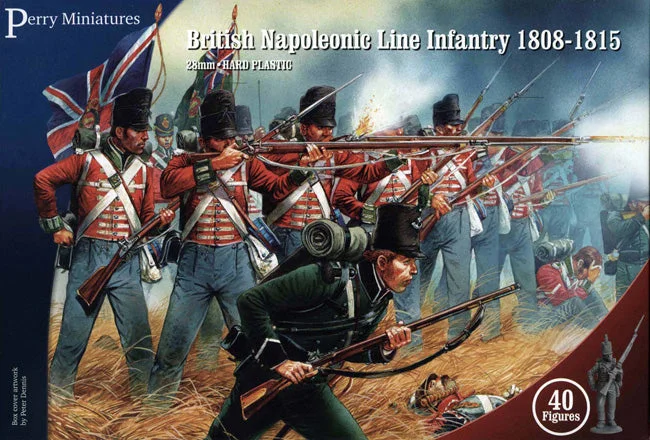- 28mm scale
- 40 Highly detailed plastic figures (36 line infantry, 4 riflemen)
- Uniform guide
- Unpainted figures, assembly with glue and painting required
- Molded in gray
Infantry of the line were so named for the dominant line combat formation used to deliver a volume of musket fire. Forming the bulk of the Napoleonic armies it was the primary offensive and defensive Arm available to the commanders during the period. Movement in line formation was very slow, and unless the battalion was superbly trained, a breakdown in cohesion was virtually assured, especially in any kind of uneven or wooded terrain. As a result, when movement over such terrain was required over a significant distance troops would move in columns and then deploy into line at their destination.
In addition, the line formation was vulnerable to cavalry charges, particularly from the flanks and rear, and these attacks usually resulted in the complete breakdown of cohesion and even destruction of the unit unless it was able to "form square".
The British Army during the Napoleonic Wars experienced a time of rapid change. At the beginning of the French Revolutionary Wars in 1793, the army was a small, awkwardly administered force of barely 40,000 men. By the end of the period, the numbers had vastly increased. At its peak, in 1813, the regular army contained over 250,000 men. The British infantry was "the only military force not to suffer a major reverse at the hands of Napoleonic France.
There were eventually 104 regiments of the line. They were numbered and, from 1781, were given territorial designations, which roughly represented the area from which troops were drawn. This was not entirely rigid, and most regiments had a significant proportion of English, Irish, Scots and Welsh together, except for certain deliberately exclusive regiments. The majority of regiments contained two battalions, while some had only one. One special case, the 60th Foot, ultimately had seven battalions. Battalions were dispersed throughout the army; it was rare for two battalions of any regiment to serve in the same brigade.
A line infantry battalion was commanded by its regimental colonel or a lieutenant colonel, and was composed of ten companies, of which eight were "centre" companies, and two were "flank" companies: one a grenadier and one a specialist light company. Companies were commanded by captains, with lieutenants and ensigns (or subalterns) beneath him. Ideally, a battalion consisted of 1000 men (excluding NCOs, musicians and officers), but active service depleted the numbers. Generally, the 1st (or senior) battalion of a regiment would draw fit recruits from the 2nd battalion to maintain its strength. If also sent on active service, the 2nd battalion would consequently be weaker.
This Perry miniatures set can be painted to represent many of the British infantry line units in active service during the Napoleonic Wars era

